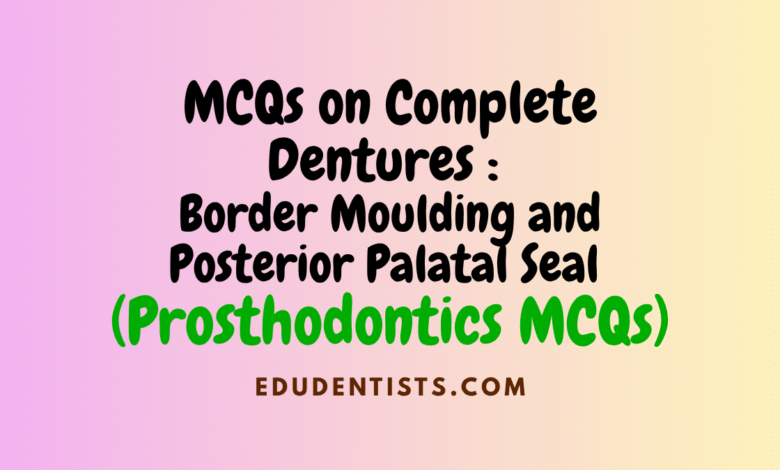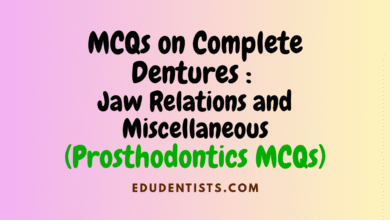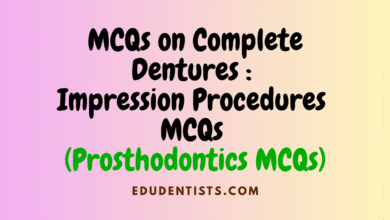Prosthodontics MCQs
MCQs on Complete Dentures : Border Moulding and Posterior Palatal Seal – Prosthodontics MCQs

MCQs on Complete Dentures : Border Moulding and Posterior Palatal Seal – Prosthodontics MCQs
- The upper denture falls when the patient opens his mouth wide. This is due to:
A. Thick labial flange
B. Over extended borders
C. Thick Disto buccal flange
D. Poor Peripheral Seal - Distolingual extension of the mandibular impression for a complete denture is limited by the action of :
A. Stylohyoid muscle
B. Medial pterygoid muscle
C. Lateral Pterygoid muscle
D. Superior Constrictor Muscle - Posterior Palatal Seal (PPS) anatomically is :
A. Pterygomaxillary notches and Fovea Palatine
B. Pterygomaxillary notches and PNS
C. Maxillary tuberosity and Pterygomandibular Raphe
D. Posterior limit of palatine bone - Secondary peripheral seal area in mandible is provided by:
A. Buccal Shelf
B. Anterior lingual Border
C. Retromolar pad
D. Crest of the ridge - Increased depth in posterior palatal seal area in mandible is provided by :
A. Tingling sensation
B. Gagging
C. Increased retention
D. Unseating of denture base - The posterior palatal seal for a maxillary complete denture :
A. Is placed immediately posterior to the vibrating line
B. Is placed immediately anterior to the vibrating line
C. Is not necessary if a metal base is made
D. Will vary in outline and depth according to the palatal form - The coronoid process :
A. Limits the extension of maxillary posterior teeth setting
B. Limits the thickness of the distobuccal flange of the upper complete denture
C. Limits the thickness of the distobuccal flange of the lower complete denture
D. Determines Posterior palatal seal - The function of the posterior palatal seal is:
A. To aid in balanced occlusion
B. To aid in insertion and removal of complete denture
C. To ensure a complete seal thus helping in retention of a denture
D. Retention of mandibular denture by sealing its posterior margin - The buccal frenal attachment of mandibular denture should be trimmed and rounded to allow proper function of :
A. Masseter
B. Buccinator
C. Triangularis
D. Zygomaticus major - Over extension of the posterior border of the denture causes:
A. Gagging sensation
B. Epulis fissuration
C. Sagging of the corners of the mouth
D. All of the above - Distal palatal termination of the maxillary complete denture base is dictated by the:
A. Vibrating line
B. Fovea palatine
C. Tuberosity
D. Maxillary torus - Incorporation of peripheral seal in an impression is necessary to obtain :
A. Stability
B. Functionally moulded periphery
C. Harmonious occlusion
D. Posterior palatal seal - In determining the posterior limit of a maxillary denture base, which of the following is on the posterior border?
A. Hamular notch
B. Hamular process
C. Fovea palatine
D. Vibrating line - Vibrating line is on the :
A. Hard palate
B. Junction of the hard palate and soft palate
C. On soft palate
D. At the junction of the muscularis uvulae and palatine muscle. - Post dam area serves mainly to:
A. Preventing ingress of food and saliva beneath denture base
B. Preventing lifting away of denture during incising
C. Stabilize the denture
D. All of the above. - Distobuccal flange of mandibular denture is influenced by:
A. Masseter
B. Buccinator
C. Temporalis
D. Platysma - Broad palatal seal indicates :
A. Type A palatal form
B. Type B palatal form
C. Type C palatal form
D. None of the above - Which of the following is not a mouth temperature waxes?
A. Adaptol
B. Korrecta type I
C. HL physiologic paste
D. IOWA paste - Posterior palatal seal is recorded when the head is bent at:
A. 30 degrees
B. 15 degrees
C. 60 degrees
D. 45 degrees - Instructing the patient to say “AH” with short vigorous bursts will help in visualizing :
A. Soft palate
B. Posterior vibrating line
C. Anterior vibrating line
D. Junction of soft and hard palate - Fovea palatine are situated in:
A. Hard palate
B. Soft palate
C. At the junction of hard and soft palate
D. Their position is not fixed - Which muscle has dual function as related to complete dentures?
A. Masseter
B. Buccinator
C. Temporalis
D. Lateral Pterygoid - The correctly placed posterior palatal seal creates :
A. Vacuum in posterior part of the palate
B. Vacuum beneath the maxillary denture
C. Partial vacuum beneath the maxillary denture
D. A close adaptation of maxillary denture at tuberosity - Anterior vibrating line is located on:
A. Soft palatal tissue
B. Hard palatal tissue
C. Either on soft or hard palatal tissue
D. Posterior to Fovea palatine - Mandibular complete denture should cover retromolar pad because:
A. More surface area gives better retention
B. Provides border seal
C. Resists movement of denture base
D. All of the above - Posterior palatal seal is seen in:
A. Hard palate
B. Soft palate
C. Junction of hard and soft palate
D. Both of them - A high tracing device is used for:
A. Extra oral graphic tracings
B. Intra oral graphic tracings
C. Cephalometric tracings
D. Determining focal forms - The average intercondylar distance which is adequate for complete dentures is:
A. 110 mm
B. 120 mm
C. 115 mm
D. 140 mm - The primary cause of Bennet movement is due to contraction of :
A. Lateral pterygoid
B. Medial pterygoid
C. Masseter
D. Temporalis - Posterior palatal seal is present on:
A. Hard palate
B. Rugae area
C. Movable soft palate
D. Immovable soft palate - Fovea palatine are:
A. Structures through which blood supply takes place
B. Mucosal salivary glands
C. Palatal termination of maxillary denture
D. Found in every individual - During recording of the posterior palatal seal, face is tilted down 30 degrees to touch the sternum:
A. to activate the muscle of palate and pharynx
B. to activate the muscle of soft palate only
C. to prevent flow of material to throat
D. to help in sucking and swallowing





